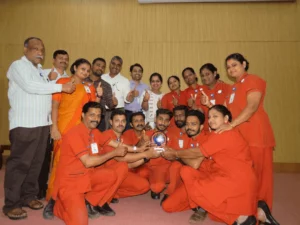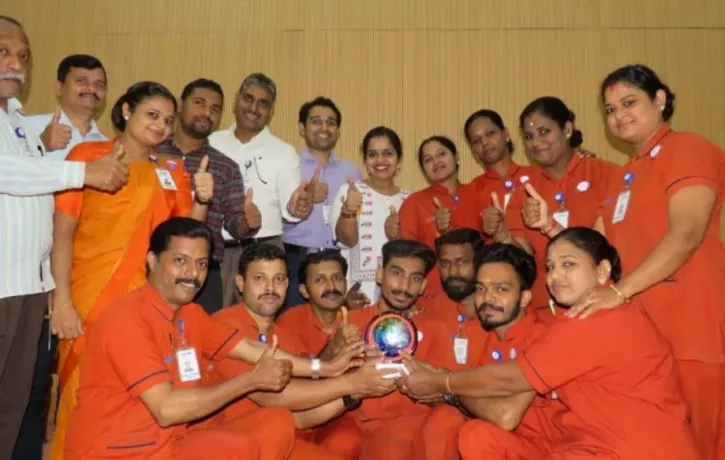Improving operational efficiency is a goal for all organizations undergoing digital transformation. But for a hospital, it’s a critical necessity.
When clinicians don’t receive vital medical tools on time, or when patient transfers are slow and inefficient, the best-case scenario is a damaged patient experience. The worst-case scenario can be fatal.
This was the challenge Baby Memorial Hospital in Kozhikode, India, was facing.
An inefficient internal transportation system was costing the hospital valuable time and money. It put patient care at risk and imposed a massive burden on the employees who were responsible for ordering and delivering the transfers.
But after implementing a real-time location system, hospital staff could handle transportation requests more efficiently.
Efficiency skyrocketed, the employee experience improved, and care providers could focus more on what they’re there for: delivering the highest quality patient care.
The successful implementation and adoption of the digital transportation system earned Baby Memorial Hospital WalkMe’s first-ever DAP Award for Employee Experience.
We spoke to Saji Mathew, COO of Baby Memorial Hospital, about the hospital’s achievement.
About the DAP Awards
WalkMe’s DAP Awards recognize organizations and individuals who successfully created and executed a digital adoption strategy to achieve digital progress. After evaluating submissions, we chose three winners from different categories to be the first recipients of the award.
The three categories of the WalkMe DAP Awards include transformation leader, customer experience, and employee experience.
Of all of the nominations for the employee experience, Baby Memorial Hospital was a clear winner.
Inefficient internal processes were taking a toll
 The easy adoption of Baby Memorial Hospital’s real-time location system dramatically improved the efficiency of transport services and created a better experience for care providers, transport staff, and patients.
The easy adoption of Baby Memorial Hospital’s real-time location system dramatically improved the efficiency of transport services and created a better experience for care providers, transport staff, and patients.
Before the development of that system, the hospital staff lacked an efficient system to request and deliver transports.
“The internal transportation system is one of the most critical services in a hospital,” says Saji. “Rapid and timely transportation of patients and materials within the hospital is essential to ensure smooth functioning. But care providers often experienced unacceptable delays when requesting transportation services. Hence, there was a need to optimize the transportation system within the hospital.”
The original workflow looked like this:
- First, a nurse would call the central control room to raise a transportation request. However, basic issues like an engaged phone line frequently slowed down the process.
- The shift supervisor manually assigned the work to an available transport staff member. Nurses often had to follow up multiple times in order to ensure their request went through.
- The transport staff member went to the pick-up location.
- He or she would then transport the item or patient to the destination.
- The transport staff member returned to the control room where they would receive their next assignment.
The reliance on manual assignments, frequent follow-ups, and a “blind” system for managing the movement of critical tools was becoming a growing source of employee frustration and an impediment to care.
Dive Deeper: Digital Adoption 101 — The Digital Leader’s Playbook
A high-tech solution sent productivity skyrocketing

For a hospital spread across three interconnected buildings, improving transportation efficiency was both a top priority and a major challenge.
Saji and his team held brainstorming sessions with clinical staff and transportation team members to fully understand their needs and develop the best possible solution.
“We wanted to focus on lean principles to eliminate the transportation waste within the hospital,” says Saji. “We also aimed to develop a system that empowers the transportation crew with technology and improve their morale and autonomy.”
They developed a system that would allow clinicians to instantly submit requests, assign them based on staff members’ locations throughout the hospital, and track them in real-time.
Here’s how it works.
Clinicians and the transport team are equipped with smartphones that are preloaded with a custom secure app. Location triangulation based on an individual’s current location in the hospital matched them with the nearest requested portable medical device, which is trackable with Bluetooth Low Energy beacons.
The ability to track both transportation personnel and medical devices in real-time eliminated the need for the control center to manually dispatch transportation assignments.
Instead, assignments are automatically given to personnel who are closest to the device at the given time.
The new process looks like this:
- Nurses submit a request for a transfer using the app. The status of the request and the availability of the nearest transport crew member are visible in real-time.
- The nearest transport staff receives the request on their smartphone.
- After accepting the request, the staff member reports to the pick-up location.
- The patient or medical tool is transported to the destination.
- The transport staff member is assigned their next pick-up task based on their current location.
Like what you’re reading? Subscribe to the blog for fresh insights delivered right to your inbox!
Digital adoption: The key to success
 The new system was promising, but its success lied in how much employees could adopt it.
The new system was promising, but its success lied in how much employees could adopt it.
There were three key components in Baby Memorial Hospital’s digital adoption strategy:
- Understanding the needs of the clinicians and the transport crew.
- Providing a technical solution that is secure, easy to use, and won’t interfere with patient interactions.
- Ensuring staff members receive adequate training so they can use the system optimally.
“The success of the implementation is rooted in the way we trained the workers,” says Saji. “It has been promoted as making patient transport workers as ‘smart’ workers and they were branded as SMART Crew members. They accepted it wholeheartedly and that uplifted their spirit.”
Boosting the employee experience — and beyond
The adoption of the real-time location system has produced a wide range of benefits.
With greater efficiency and autonomy, the system serves as a great tool to empower the transportation crew. A better way of working and higher morale contributed to a 10% rise in employee satisfaction scores.
On the operational side, the system has become a proven best practice.
In its first year, employees used the system to handle 240,000 requests, saving the hospital critical time and money.
Now, nurses can complete requests much faster — from 3 minutes on the phone to a mere 15 seconds via the app. The wait time also decreased from 20-30 minutes per request to 10-15 minutes.
Altogether, the system saves the hospital more than 10,000 hours of work per year, enabling them to focus more time on delivering high-quality patient care.
Keeping the patient at the center
Every initiative in the hospital comes back to patient care.
With the ability to harness technology, empower staff, and improve operational efficiency, caregivers can improve the quality of care and the patient experience.
Baby Memorial Hospital’s early success with its new internal transportation system made it clear: with the right tools and the right digital adoption strategy, anything is possible.
Congratulations to Baby Memorial Hospital on winning the WalkMe DAP Award for the Employee Experience category!
WalkMe’s Digital Adoption Platform (DAP) transforms the user experience in today’s overwhelming digital world. Using artificial intelligence, engagement, guidance, and automation, WalkMe’s transparent overlay assists users to complete tasks easily within any enterprise software, mobile application or website. Discover how a DAP can revolutionize your business.

